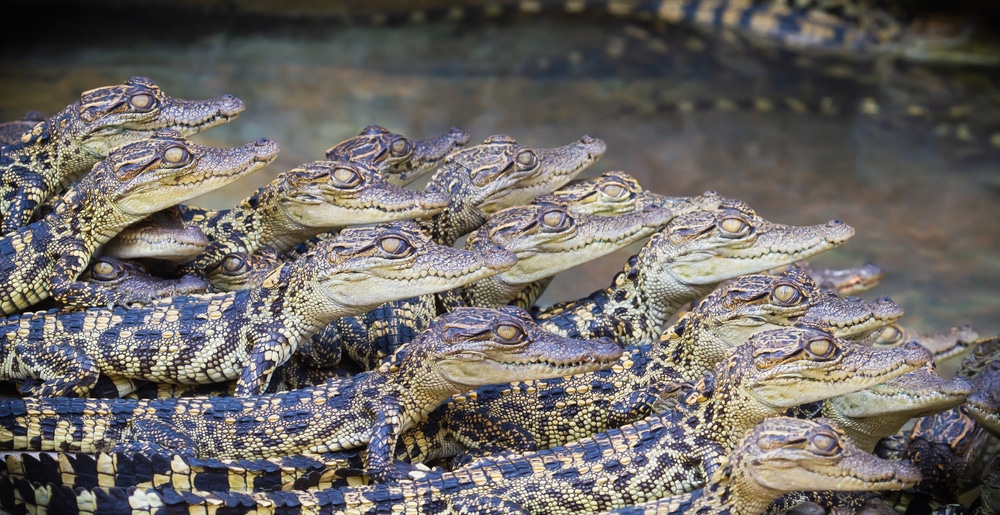In the rivers and lakes of sub-Saharan Africa, one of the continent’s most feared predators is quietly challenging long-held assumptions about reptilian behavior. The Nile crocodile (Crocodylus niloticus), long viewed as a cold-blooded killer with unmatched jaw strength, is now also being recognized as a surprisingly attentive and strategic parent.
New research into the species’ nesting, hatching, and post-natal behaviors reveals a system of intensive maternal investment, communication, and protective tactics more often associated with birds or mammals. This isn’t a behavioral anomaly—it’s a deeply embedded survival mechanism for a species under constant threat, not just from the environment, but from its own kind.

The paradox is stark. This apex predator, capable of exerting over 5,000 pounds of bite force, uses the same anatomical machinery to gently carry dozens of fragile hatchlings from nest to water’s edge. And it does so while fending off what is, statistically, the most likely predator of its young: other adult crocodiles.
Apex Strength Meets Delicate Control
The maternal transport of hatchlings, extensively documented in the BBC Wildlife Magazine, is one of the most intricate and energy-consuming behaviors recorded in reptiles. After guarding her nest for around 90 days, the mother Nile crocodile responds to vocalizations from the hatching young, excavating the sandy nest chamber using her snout and mouth.
Hatchlings are carefully carried in the gular pouch, a specialized valve-like area of the throat that typically keeps water out of the lungs. For transport, this pouch acts as a cushioned cradle for multiple juveniles—each just 30 cm long and weighing approximately 70 grams.
A detailed account published in the BBC Wildlife article notes that mothers have been observed making 13 individual trips between the nest and water, investing over 32 hours of continuous effort in relocating a single clutch. The jaw muscles, built for destruction, are precisely controlled to exert minimal pressure during transport—a physiological feat that underscores the evolutionary significance of this behavior.
A Nile crocodile hatchling being carried in the jaws of an adult. Credit: Getty
The process is triggered by synchronized distress calls emitted from inside the nest, prompting the mother to begin retrieval and even help hatch unbroken eggs—often using her tongue.
Crocodiles Eat Their Young—Unless Protected
The most immediate threat to Nile crocodile hatchlings is not environmental—it’s cannibalism by adult conspecifics, a fact well documented in both field observations and academic studies. According to a research paper on nest predation and maternal care conducted at Lake St. Lucia, South Africa, attacks by larger crocodiles represent the leading cause of hatchling mortality.
To counter this, mothers often move their young to a communal nursery area, or crèche, where they continue to guard them aggressively. While some reports suggest maternal care may taper after two months, field data indicate that protection can last up to two years, especially until juveniles reach a length of around 1.2 meters—when their chances of survival rise.

Both male and female Nile crocodiles have been observed participating in the defense of young, though maternal care remains dominant. This cooperative guarding behavior remains one of the rare instances of extended post-natal care in reptiles, and it has measurable survival value.
At Lake Kyoga in Uganda, conservation programs that mimic maternal protection have reported significant success. Interventions that shield hatchlings during the vulnerable early stages—essentially replicating the role of the mother—have led to survival rate increases of up to 40%, according to field reports cited in the BBC Wildlife article.
Climate Shift Threatens Sex Ratios
Despite these evolved reproductive strategies, a climate-sensitive biological process puts Nile crocodile populations at risk. Like many reptile species, crocodiles rely on Temperature-Dependent Sex Determination (TSD), meaning the sex of the hatchlings is determined not genetically, but by the temperature at which eggs incubate.
As summarized in the BBC Wildlife piece, temperatures below 30°C predominantly yield females, while temperatures between 32°C and 33°C tend to produce males. Even slight, sustained increases in environmental heat can skew these ratios dangerously, reducing population viability over time.
With climate change accelerating in key Nile crocodile habitats, this thermal dependence presents a serious long-term threat. Distorted sex ratios could lead to local breeding bottlenecks or collapse, especially in isolated or already stressed populations.
This vulnerability is especially alarming considering how little control the species has over incubation temperatures in the wild. Nest location, shade cover, and microclimate conditions—once relatively stable—are becoming less predictable, compounding the risk to hatchling development and demographic balance.
Evolution’s Edge Is Narrowing
The Nile crocodile’s survival strategy, forged over millions of years, is both elegant and brutal. From the synchronized calls that initiate the hatching process to the prolonged defense of communal nurseries, its reproductive behavior reflects an unusually complex and costly investment for a reptile.
But evolution cannot keep pace with the speed of current environmental changes. While cannibalism, nest predation, and drought have long shaped crocodilian life cycles, the added pressures of rising temperatures, habitat encroachment, and human disturbance now introduce variables the species may not be able to absorb.
Conservation models that replicate or support maternal care are proving effective at boosting hatchling survival. But the question of long-term viability remains—especially if climate-driven sex distortions undermine the reproductive foundation.

